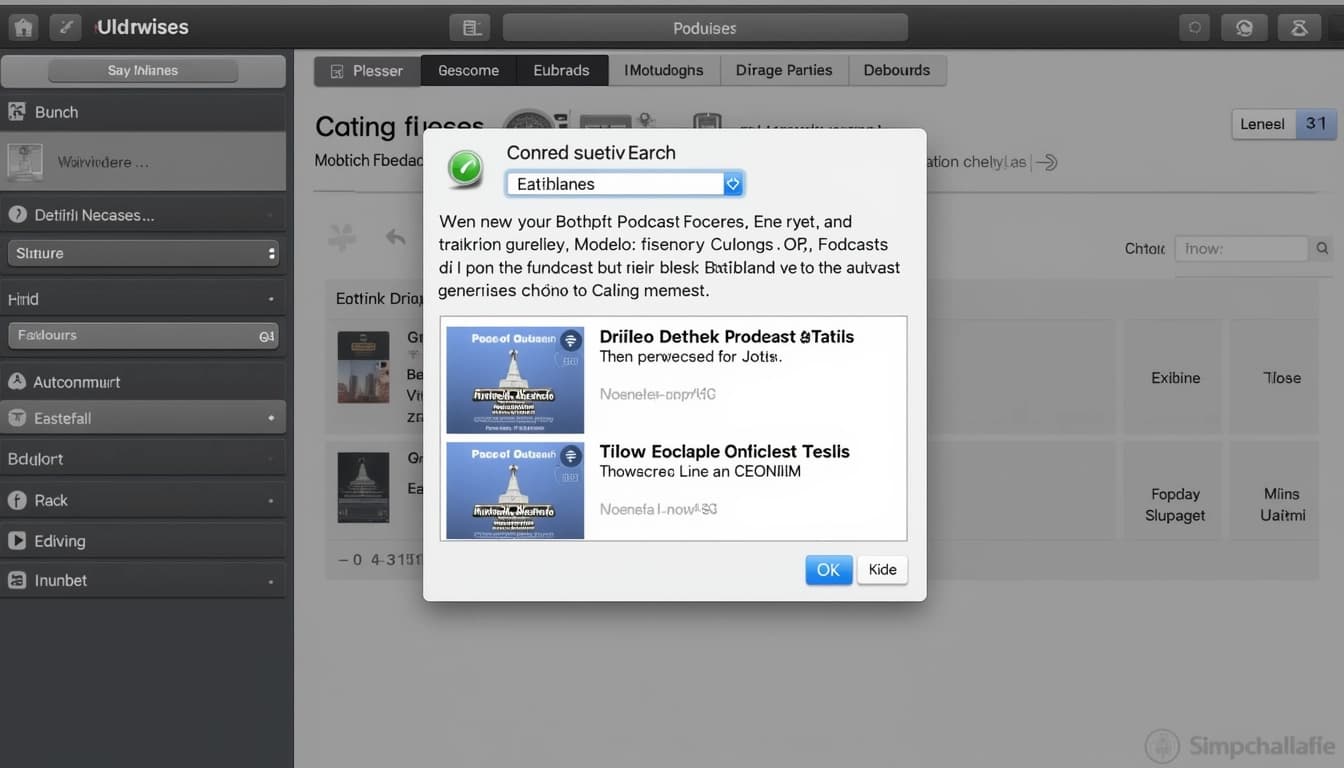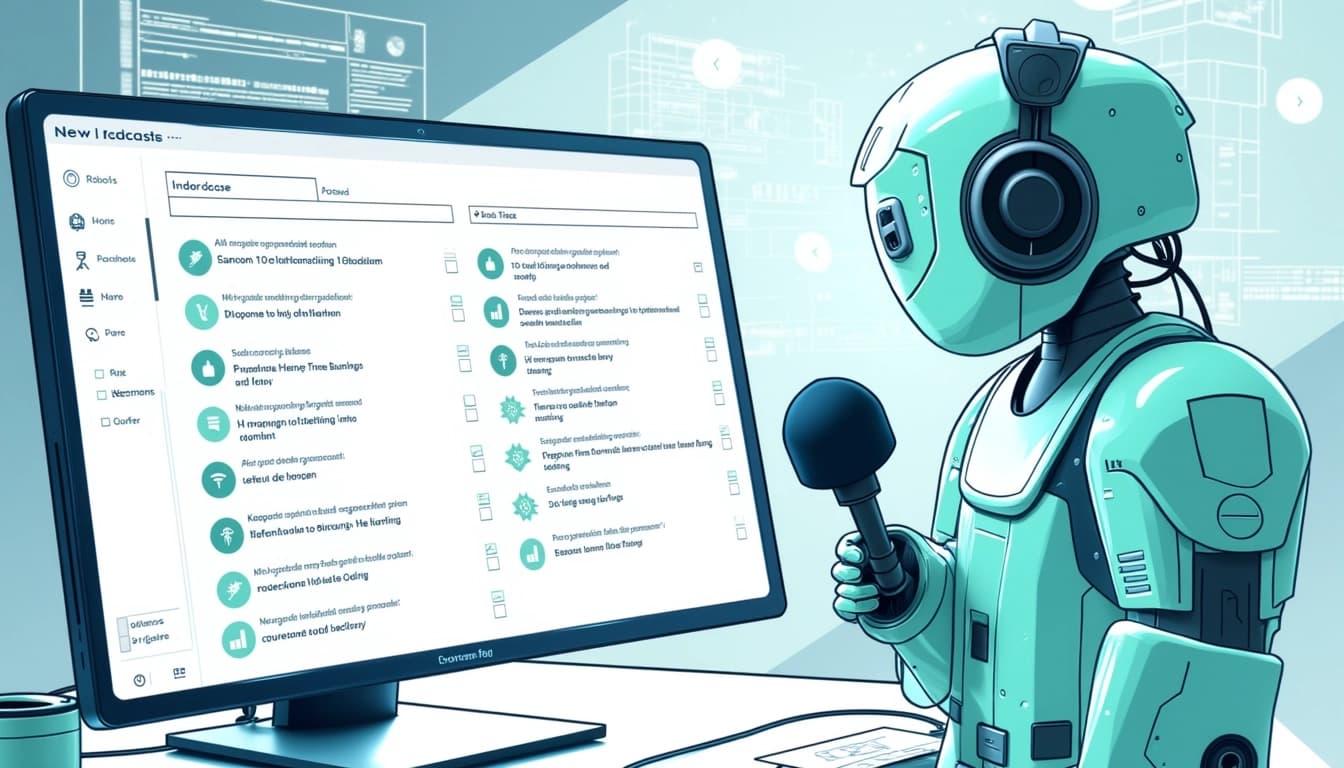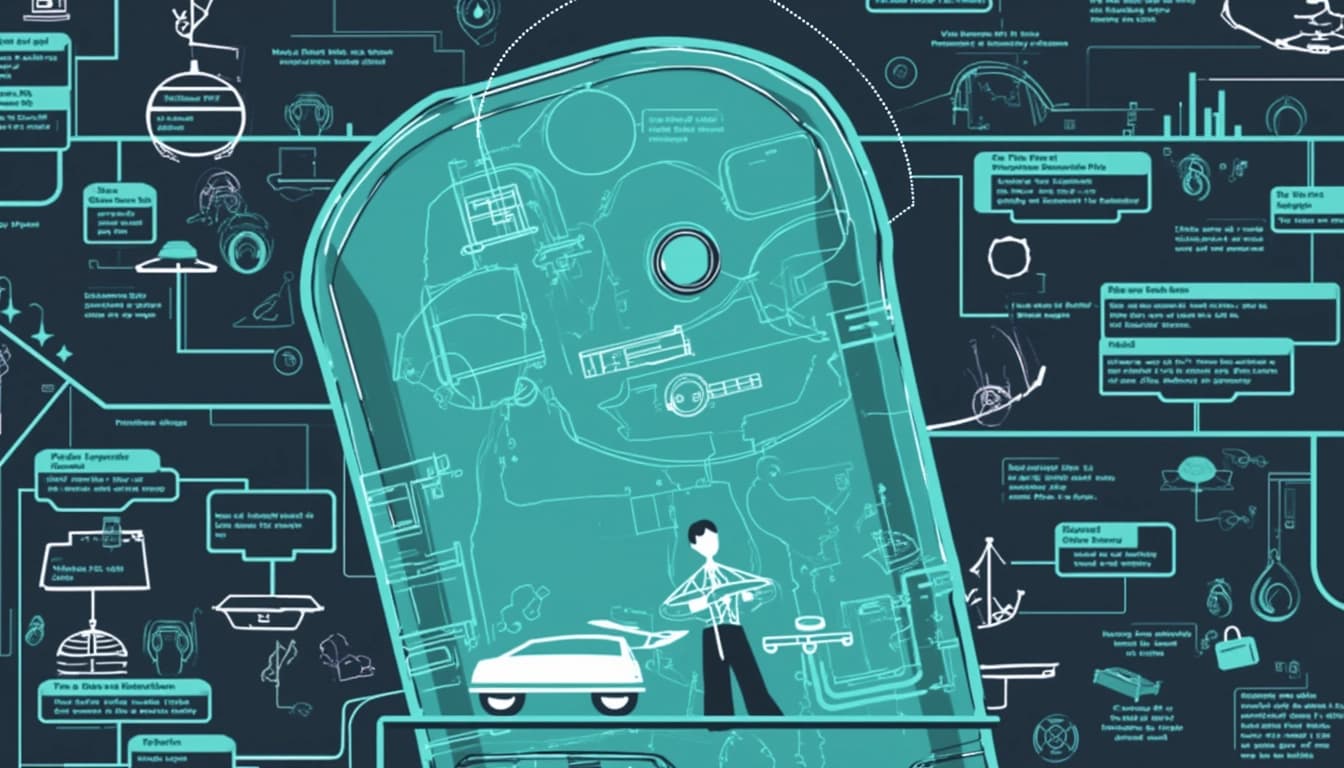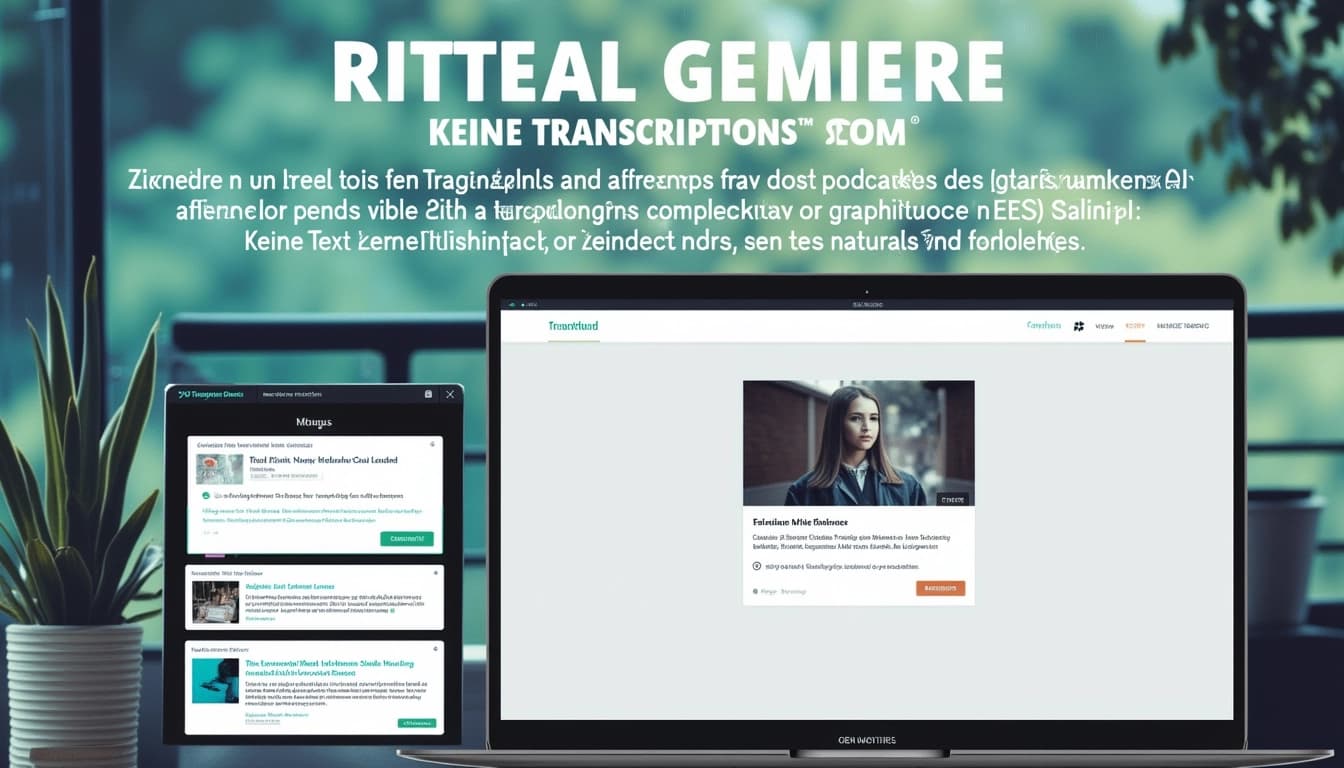
Automatically Transcribe Your Podcasts with AI
By John Doe 5 min
Automatically Transcribe Your Podcasts with AI
Imagine if every word from your podcast could be captured in writing, effortlessly and accurately. Thanks to advances in artificial intelligence, this is now a reality. AI-powered transcription can turn your podcast audio into text in minutes, saving you hours of manual work. Whether you’re a business owner wanting to boost content marketing, an educator striving to support all learners, or a podcaster looking to grow your audience, automatic transcription offers game-changing benefits. In this article, we’ll explore why transcribing your podcasts is worth it and how AI makes it easier than ever. We’ll also highlight the real-world advantages – from improved accessibility and SEO to content repurposing and engagement – and introduce popular AI transcription tools like Otter.ai, Descript, and Whisper that can do the heavy lifting for you. Let’s dive in!
Enhance Accessibility for All Listeners
One of the most compelling reasons to transcribe your podcasts is accessibility. Audio content is inherently inaccessible to those who are deaf or hard of hearing – a group that makes up nearly 20% of the global population (7 Key Benefits of Podcast Transcription | Transcribe). By providing a written transcript alongside your audio, you ensure that everyone in your potential audience can access and enjoy your content (7 Key Benefits of Podcast Transcription | Transcribe).
According to the World Health Organization, over 5% of the world's population has disabling hearing loss. By providing transcripts, you make your podcast accessible to people with hearing impairments. This demonstrates a commitment to inclusivity and can significantly expand your reach to new listeners who would otherwise be excluded.
Boost SEO and Discoverability
If you're looking to grow your podcast's audience, search engine optimization (SEO) is key – and transcripts can dramatically improve your SEO. Search engines like Google can't listen to audio, but they can crawl text. By transcribing your podcast, you provide search engines with rich, keyword-dense content that helps your episodes rank higher in search results.
Supporting Non-Native Speakers
Transcripts aren't just for people with hearing impairments. They also help non-native speakers who might find it easier to read English than to follow rapid spoken dialogue. Consider listeners in situations where audio isn't practical – someone in a noisy cafe or a quiet library. A transcript gives them a way to consume your podcast without missing anything.
Enhancing User Engagement
Written transcripts provide a convenient alternative for those who simply prefer reading over listening, so they don't have to miss out on your amazing content. In educational settings, an instructor can record lectures or discussions and offer transcripts to students for review, ensuring all learners can follow along at their own pace.
Conclusion & Next Steps
In short, transcription makes your podcast accessible to a wider audience on their terms. It boosts SEO, supports non-native speakers, and enhances engagement. Start transcribing your episodes today to unlock these benefits and grow your audience.

- Improve accessibility for hearing-impaired listeners
- Enhance SEO and discoverability
- Support non-native speakers and auditory learners
Transcribing your podcast episodes provides Google with a text version of your content, making it easier for search engines to index and understand. This allows all the keywords and topics discussed in your show to become searchable on the web, increasing the chances of discovery.
SEO Benefits of Podcast Transcription
By adding transcripts to your podcast, you can significantly improve your search engine rankings. A study by Moz found that podcasters experienced a 15% increase in organic traffic and a 50% boost in keyword rankings after implementing transcripts. This makes your content more visible to potential listeners searching for related topics.
How Transcripts Improve Search Rankings
Transcripts act as a rich source of keywords and context for search engines. Publishing them on your website or blog as standalone articles or show notes helps your pages rank higher in search results. Over time, these transcript pages can attract organic traffic, leading more people to your podcast.
Enhancing User Engagement
Having a text version of your podcast on your website can also improve user engagement. Visitors who read the transcript may spend more time on your site, which signals to search engines that your content is valuable. This can further boost your SEO performance and attract more leads.

Accessibility and Reach
Transcripts make your podcast accessible to a wider audience, including those who are deaf or hard of hearing. They also cater to people who prefer reading over listening, expanding your potential listener base. This inclusivity can further enhance your brand's reputation and reach.
Conclusion & Next Steps
Transcribing your podcast episodes is a simple yet powerful way to improve SEO, accessibility, and user engagement. By making your content searchable and readable, you can attract more listeners and grow your audience. Start transcribing your episodes today to unlock these benefits.

- Increase organic traffic with transcripts
- Improve keyword rankings for better visibility
- Enhance accessibility for a broader audience
Your podcast episodes are treasure troves of content – why not reuse that content in new ways? With transcripts in hand, you can repurpose your podcast into many formats without starting from scratch. For example, you might turn an insightful podcast episode into a blog post or article by editing the transcript into a prose format.
Repurpose Content and Extend Your Reach
Many podcasters use transcripts as the foundation for written articles, email newsletters, or social media posts. By doing so, you’re recycling one piece of content into multiple channels, allowing you to reach people who may prefer reading blogs or scrolling social media over listening to audio. The transcript provides the core material – you can summarize it, pull out key points or quotes, and tailor it to different platforms and audiences.
Maximize ROI with Repurposed Content
This kind of repurposing not only saves you time (since you don’t have to write something entirely new) but also maximizes the ROI of each podcast episode. For businesses, a single podcast can yield a podcast episode, a blog article, a series of tweetable quotes, and more – all driving home your message consistently. Educators can transcribe a recorded lecture or panel discussion and then adapt that text into study guides or course handouts.
Enhance Accessibility and Engagement

Conclusion & Next Steps
Transcribing your podcast episodes opens up numerous opportunities to expand your reach and engage with diverse audiences. Whether you're repurposing content for blogs, social media, or educational materials, transcripts provide a versatile foundation. Start transcribing today and unlock the full potential of your podcast content.
- Convert podcast transcripts into blog posts
- Create social media snippets from key quotes
- Develop educational materials from lecture transcripts
Podcasts are a fantastic way to share ideas, but they can be even more powerful when you provide transcripts. Transcripts make your content accessible to a wider audience, including those who are deaf or hard of hearing. They also improve SEO, making it easier for search engines to index your content and for listeners to find specific sections.
Enhance Accessibility with Transcripts
Transcripts ensure that your podcast is accessible to everyone, including those who rely on text due to hearing impairments. By providing a written version of your audio content, you make it possible for more people to engage with your material. This inclusivity not only broadens your audience but also demonstrates your commitment to accessibility.
SEO Benefits of Transcripts
Search engines can’t listen to audio, but they can read text. By transcribing your podcast, you give search engines more content to index, which can improve your rankings. Keywords and phrases from your podcast become searchable, helping potential listeners discover your content more easily.
Reach International Audiences
Transcripts can be translated into other languages, allowing you to reach non-English speaking audiences. Translation tools can quickly convert your text, making your content accessible to a global audience. This expansion can significantly increase your listener base and diversify your reach.
Increase Audience Engagement
Transcripts make your content searchable and skimmable, allowing listeners to find specific segments quickly. This convenience enhances the user experience, as fans can revisit key points without scrubbing through audio. It also keeps your audience engaged by letting them interact with your content on their terms.
Conclusion & Next Steps
Providing transcripts for your podcast is a simple yet powerful way to enhance accessibility, improve SEO, and expand your audience. By making your content more discoverable and inclusive, you can grow your listener base and increase engagement. Consider using transcription tools or services to streamline the process.
- Improve accessibility for hearing-impaired listeners
- Boost SEO with searchable text
- Expand reach through translations
Transcripts significantly enhance accessibility for your podcast audience. They allow people who are deaf or hard of hearing to engage with your content, ensuring inclusivity. Additionally, transcripts cater to non-native speakers who might find reading easier than listening, improving comprehension and retention.
Boosting SEO and Discoverability
Search engines can't listen to audio, but they can crawl text. By transcribing your podcast episodes, you make your content searchable, increasing the chances of ranking for relevant keywords. This helps attract new listeners who might not have discovered your podcast otherwise. Transcripts also provide more material for search engines to index, improving your overall visibility.
Keyword Optimization Opportunities
With a transcript, you can identify and optimize for keywords naturally used in your conversation. This organic integration of keywords enhances SEO without sounding forced. It also allows you to repurpose transcript snippets for blog posts or social media, further amplifying your reach.
Encouraging Sharing and Interaction
Transcripts make it easy for listeners to share standout quotes or moments from your podcast. They can copy and paste text snippets directly onto social media platforms, sparking discussions and attracting new audiences. This word-of-mouth promotion is invaluable for growing your podcast's reach organically.

Catering to Audience Preferences
Some listeners prefer reading over listening, whether due to personal preference or situational constraints like noisy environments. Transcripts accommodate these preferences, ensuring your content is accessible in multiple formats. Others may use transcripts as companions to the audio, reinforcing their understanding or revisiting key points easily.
Conclusion & Next Steps
Transcripts are a powerful tool for enhancing accessibility, SEO, and audience engagement. By providing text versions of your podcast, you open doors to new listeners and deepen connections with existing ones. Start transcribing your episodes today to unlock these benefits and grow your podcast's impact.
- Improve accessibility for diverse audiences
- Boost SEO and discoverability
- Facilitate social sharing and engagement
- Cater to different content consumption preferences
Transcribing your podcast episodes can offer numerous benefits, from improving accessibility to boosting SEO. By converting spoken content into text, you make your podcast available to a wider audience, including those who prefer reading or have hearing impairments. Additionally, search engines can index the text, making it easier for potential listeners to discover your content.
How AI Simplifies the Transcription Process
You might be thinking, 'Transcribing sounds useful, but it also sounds like a lot of work!' – and traditionally, it was. Manual transcription meant painstakingly listening and typing out every word, or paying for professional transcribers. That could take many hours and, if outsourced, could cost a significant amount (usually charged per minute of audio). AI transcription changes the game entirely. Modern AI speech-to-text services can convert your audio to text in a matter of minutes, with surprisingly high accuracy.
The Convenience of AI Transcription
The convenience factor is huge. With AI tools, you typically just upload your podcast audio (or even record directly within the tool), and the system will automatically generate the transcript for you. Many AI transcription platforms also handle punctuation, speaker identification, and formatting automatically. For example, if your podcast has multiple speakers, the AI can label each speaker in the text – so the transcript reads like a script with speaker names, without you having to tag who said what manually.
Accuracy and Improvements in AI Transcription
Accuracy of AI transcription has improved dramatically in recent years thanks to innovations like OpenAI’s Whisper. Advanced AI can even learn speaker voices over time to improve identification. The result is a clean, readable transcript that you might only need to lightly proofread for minor errors or unique names.
Conclusion & Next Steps
In summary, AI transcription offers a fast, cost-effective, and highly accurate way to transcribe your podcast episodes. By leveraging these tools, you can enhance accessibility, improve SEO, and engage a broader audience. Consider trying out an AI transcription service for your next episode to experience the benefits firsthand.
- Improves accessibility for hearing-impaired listeners
- Boosts SEO by making content searchable
- Saves time and money compared to manual transcription
Whisper was trained on 680,000 hours of multilingual audio, making it exceptionally good at understanding different accents and even picking out speech amid background noise. In practical terms, today’s AI can get most of the words right even if your guest has an accent or if there’s a bit of noise in the recording.
Of course, no AI is 100% perfect yet – you’ll still want to review the output – but the time it takes to correct a few errors is nothing compared to transcribing from scratch. In many cases, the AI-generated text is near human-level accuracy for clear recordings.
Popular AI Transcription Tools and Platforms
Another benefit is that AI transcription can be done on-demand and at scale. Have a backlog of 100 episodes you wish you had transcripts for? You can feed them into an automated service and get transcripts for all of them relatively quickly, something that would be impractical to do manually.
Many services charge a reasonable monthly fee or a low per-minute rate, which often turns out to be far cheaper than hiring human transcribers. In short, AI takes the headache out of transcription. It transforms what used to be a tedious task into a quick, automated step in your podcast workflow, so you can focus on creating content rather than typing it out.
https://www.theverge.com/23316220/transcription-ai-otter-temi-how-toAI-driven transcription tools have become abundant and user-friendly, each with its own special features. Here are a few popular options (including those used by many professionals and creators) that can help you transcribe your podcasts with ease.
Otter.ai
A widely-used transcription service known for its real-time transcriptions and meeting notes. Otter.ai can transcribe conversations live (even during a Zoom or Google Meet call) and automatically provides an outline and summary of the transcript. It organizes your transcripts into searchable notes, lets you highlight or comment on sections, and even generates a list of actionable items from meetings. Otter offers a free plan for individuals and has business plans for teams, making it a convenient choice for both personal podcast projects and organizational use.
Descript
An all-in-one audio and video editing tool that includes powerful transcription features. Descript will transcribe your podcast and then allow you to edit your audio by editing the text. This means you can delete a sentence in the transcript, and it will cut that portion out of the audio – it’s like editing a Word document and simultaneously editing your podcast. Descript can automatically remove filler words like 'um' and 'uh' from both the text and audio, saving you editing time.
Key Features of Descript
Descript is particularly useful for podcasters who want to streamline their workflow. The ability to edit audio by editing text is a game-changer, reducing the need for complex audio editing software. Additionally, Descript supports collaborative editing, making it easy for teams to work together on podcast episodes.
Other Popular Transcription Tools
Beyond Otter.ai and Descript, there are several other AI transcription tools worth considering. Tools like Temi, Sonix, and Trint offer varying levels of accuracy, pricing, and features. Each tool has its strengths, so it’s worth trying a few to see which one best fits your needs.
Conclusion & Next Steps
AI transcription tools have revolutionized the way podcasters and content creators handle audio content. Whether you need real-time transcription, collaborative editing, or advanced features like filler word removal, there’s a tool out there for you. The key is to experiment with different options and find the one that best suits your workflow and budget.
- Try out Otter.ai for real-time transcription and meeting notes.
- Explore Descript for text-based audio editing and collaboration.
- Consider other tools like Temi or Sonix for additional features.
In the rapidly evolving world of digital content creation, transcription tools have become indispensable. They save time, improve accessibility, and enhance productivity by converting spoken words into written text. Whether you're a journalist, podcaster, or content creator, having a reliable transcription tool can make a significant difference in your workflow.
Otter.ai – Best for Real-Time Transcription
Otter.ai stands out for its real-time transcription capabilities, making it ideal for live meetings, interviews, and lectures. The tool uses advanced AI to transcribe speech as it happens, allowing users to follow along and even search through the transcript later. Beyond transcription, Otter.ai offers features like speaker identification and integration with platforms like Zoom, making it a versatile choice for professionals.
Key Features of Otter.ai
Otter.ai's real-time transcription is powered by AI that adapts to different accents and background noise. It also allows users to edit transcripts, add comments, and highlight important sections. The tool supports multiple languages and offers cloud storage for easy access to transcripts from any device.
Descript – Best for Content Creators
Descript is more than just a transcription tool; it’s a comprehensive audio and video editing platform. It combines transcription with multi-track editing, screen recording, and even AI voice cloning. This makes it a favorite among podcasters, video creators, and marketers who need a seamless workflow from recording to publishing.
OpenAI Whisper – Best for Accuracy
OpenAI Whisper is an open-source AI model that has set new benchmarks for transcription accuracy. It excels in handling diverse languages, accents, and noisy environments. While it requires some technical know-how to use directly, many third-party services now leverage Whisper’s capabilities to offer high-quality transcription.
Why Whisper Stands Out
Whisper’s ability to transcribe and translate speech in multiple languages makes it a powerful tool for global applications. Its open-source nature also means continuous improvements from the developer community, ensuring it stays at the forefront of transcription technology.
Rev – Best for Professional Use
Rev.com offers both AI-generated and human transcription services, catering to different needs and budgets. Its AI transcription is fast and affordable, while human transcription guarantees near-perfect accuracy. Rev also provides captioning and subtitling services, making it a go-to for video producers and educators.

Conclusion & Next Steps
Choosing the right transcription tool depends on your specific needs. For real-time transcription, Otter.ai is unmatched. Descript offers a full suite of editing tools, while Whisper provides cutting-edge accuracy. Rev combines speed and precision with professional options. Evaluate your requirements and try out these tools to find the best fit for your workflow.
- Consider your budget and accuracy requirements
- Test multiple tools to see which one integrates best with your workflow
- Look for additional features like speaker identification or multi-language support
Podcast transcription is becoming increasingly popular as it helps in making content more accessible and searchable. By converting audio into text, listeners can read along or revisit key points without replaying the entire episode. This is especially useful for those who prefer reading over listening or for non-native speakers who might find it easier to follow written content.
Why Transcribe Your Podcast?
Transcribing your podcast offers numerous benefits, including improved SEO, better accessibility, and enhanced content repurposing. Search engines can index the text, making it easier for potential listeners to discover your podcast through search queries. Additionally, transcripts make your content accessible to the hearing impaired, ensuring inclusivity.
SEO Advantages
Transcripts provide search engines with rich, indexable text, which can significantly boost your podcast's visibility. Keywords and phrases within the transcript help search engines understand the content, leading to higher rankings. This is a game-changer for podcasters looking to expand their audience organically.
Top Tools for Podcast Transcription
Several tools can help you transcribe your podcast efficiently. Otter.ai, for example, uses AI to provide real-time transcription with high accuracy. Rev offers both automated and human-reviewed transcription services, ensuring quality. These tools save time and effort, allowing you to focus on creating great content.
Practical Applications
Transcripts can be repurposed into blog posts, social media snippets, or even eBooks. Businesses can use them to create detailed reports or training materials. The possibilities are endless, making transcription a valuable investment for any podcaster or content creator.
Conclusion & Next Steps
Transcribing your podcast is a simple yet powerful way to enhance accessibility, improve SEO, and repurpose content. Start by choosing a transcription tool that fits your needs and budget. Experiment with different methods to find what works best for your workflow.
- Improve SEO with transcripts
- Enhance accessibility for all listeners
- Repurpose content for multiple platforms
AI transcription is revolutionizing the way professionals, educators, and content creators work with audio and video content. By converting spoken words into written text, AI transcription tools save time, enhance accessibility, and unlock new possibilities for content repurposing. Whether you're a business professional, educator, or independent podcaster, understanding how to leverage AI transcription can significantly boost your productivity and reach.
Business Professionals & Teams
For business professionals, AI transcription transforms meetings, interviews, and brainstorming sessions into searchable, shareable documents. Imagine recording a client meeting and having an AI generate a transcript within minutes—no more frantic note-taking or misremembered details. Sales teams can review customer calls to identify pain points and opportunities, while HR departments can document interviews for future reference. Transcripts also make it easier to create summaries or action items, ensuring everyone is on the same page.
Enhancing Collaboration
With AI-generated transcripts, remote teams can collaborate more effectively. Team members who couldn’t attend a meeting can quickly catch up by reading the transcript, and key decisions or ideas are preserved in writing. This reduces misunderstandings and keeps projects moving forward smoothly. Plus, transcripts can be translated into other languages, making them invaluable for global teams.
Educators and Trainers
Educators can use AI transcription to make their lectures and training sessions more accessible. Students who miss a class can read the transcript to catch up, and those with learning disabilities or non-native English skills benefit from having written material to review. Transcripts can also be compiled into study guides or course readers, providing a valuable resource for learners. For example, a language teacher might record conversations in a foreign language and provide transcripts to help students practice reading and comprehension.
Creating Study Materials
Transcripts can be formatted to highlight key terms or concepts, making them even more useful as study aids. Timestamps can be added to help students locate specific parts of a lecture, and transcripts can be shared in downloadable formats for offline access. This flexibility ensures that all students, regardless of their learning preferences, can benefit from the material.
Independent Podcasters and Creators
For solo podcasters and content creators, AI transcription is a game-changer. Transcripts make your content accessible to a wider audience, including those who prefer reading over listening. They also improve SEO, making it easier for new listeners to discover your podcast. Additionally, transcripts can be repurposed into blog posts, social media snippets, or even eBooks, maximizing the value of your content.
Repurposing Content
Transcripts allow you to easily extract quotes, anecdotes, or key points from your episodes to share on social media. You can turn a single podcast episode into multiple pieces of content, saving time and effort while reaching more people. For example, a storytelling podcast could publish transcripts as standalone blog posts, inviting readers to engage with the stories in a different format.
Conclusion & Next Steps
AI transcription is a powerful tool that can save time, improve accessibility, and help you get more value from your audio and video content. Whether you're a business professional, educator, or content creator, integrating AI transcription into your workflow can lead to greater efficiency and broader reach. Start by exploring transcription tools that fit your needs, and experiment with different ways to use transcripts to enhance your work.
- Choose an AI transcription tool that suits your needs
- Experiment with using transcripts for meetings, lectures, or content repurposing
- Share your transcripts to improve accessibility and SEO
Promote your transcript availability to your listeners. For instance, mention in your episode outro that a full transcript is on your website. This lets listeners know they have that option. Also, don’t shy away from using the transcript for your own reference – many creators use the transcript to quickly locate something said in an earlier episode (it’s much easier than scrubbing through audio).
Getting started with AI transcription is straightforward
Pick one of the AI tools and try it out with your latest episode. Many have free or trial options, so you can see the results firsthand. Once you receive the transcript, give it a quick read-through to fix any minor errors (AI might mishear the occasional word, especially names or technical jargon). After that, you can publish the text or use it however you like. Incorporating transcription into your workflow may add a small step, but the payoff in accessibility, content value, and audience growth is well worth it. As we’ve seen, it enables new ways for people to engage with your material and for you to get more mileage out of every episode.
Conclusion: Embrace the Power of AI Transcription
In the world of podcasts and audio content, AI transcription is a true game-changer. It takes something as transient as spoken words and turns it into lasting text that can be searched, shared, and transformed into countless new formats. By automatically transcribing your podcasts, you make your content more accessible, boost your visibility on the web, create material for blogs and social media, and keep your audience more deeply engaged. And thanks to artificial intelligence, all these benefits come at a fraction of the time and cost it would take to do manually.
For businesses, educators, and independent creators alike, AI levels the playing field – you don’t need a big budget or specialist skills to generate quality transcripts. With tools like Otter.ai, Descript, Whisper, and others at your fingertips, you can easily integrate transcription into your content strategy.
Podcasts have become a powerful medium for sharing ideas, stories, and expertise. However, many podcasters overlook the potential of transcribing their episodes. By converting spoken words into written text, you can significantly enhance accessibility, improve SEO, and provide additional value to your audience. This article explores why automatic transcription is a game-changer for podcasters and how AI tools like Whisper make it easier than ever.
The Power of Podcast Transcription
Transcribing your podcast episodes unlocks numerous benefits. First, it makes your content accessible to individuals with hearing impairments, ensuring inclusivity. According to the World Health Organization, over 5% of the global population has disabling hearing loss. By providing transcripts, you cater to this audience and expand your reach. Additionally, transcripts improve SEO by making your content searchable. Search engines can index the text, helping your podcast appear in relevant search results and driving organic traffic.
Boosting Engagement and Shareability
Transcripts also enhance engagement. Many listeners prefer reading along while listening, especially for complex topics. Transcripts allow them to revisit key points, take notes, or share specific quotes on social media. This increases the likelihood of your content being shared and discussed. Moreover, transcripts can be repurposed into blog posts, articles, or social media snippets, maximizing the value of your podcast episodes.
AI-Powered Transcription with Whisper
Gone are the days of manual transcription, which is time-consuming and error-prone. AI tools like Whisper by OpenAI offer fast, accurate, and cost-effective transcription. Whisper uses advanced machine learning to convert speech to text, even handling accents, background noise, and technical jargon. You can simply upload your audio file, and the AI generates a transcript in minutes. This technology is continually improving, ensuring higher accuracy over time.
Getting Started with Transcription
If you haven’t started transcribing your podcast, now is the perfect time. Begin by using a free trial of an AI transcription tool to test the process. Experiment with different formats, such as full transcripts or summarized versions, and gather feedback from your audience. You’ll likely find that transcripts add significant value, making your content more versatile and inclusive. Embrace AI transcription to stand out in a crowded podcasting landscape.
Conclusion & Next Steps
Transcribing your podcast episodes is a simple yet powerful way to enhance accessibility, improve SEO, and engage your audience. With AI tools like Whisper, the process is easier and more affordable than ever. Start small, experiment with different approaches, and measure the impact on your podcast’s growth. By making your content more accessible and searchable, you’ll unlock new opportunities to connect with your audience and grow your brand.
- Make your podcast accessible to a wider audience
- Improve SEO and drive organic traffic
- Repurpose transcripts into blog posts or social media content
Podcast transcription is a powerful tool that can significantly enhance your content strategy. By converting spoken words into written text, you can reach a broader audience, improve accessibility, and repurpose your content across multiple platforms. This article explores the key benefits of podcast transcription and how it can elevate your podcasting efforts.
Enhanced Accessibility and Reach
Transcribing your podcast episodes makes them accessible to individuals who are deaf or hard of hearing, ensuring inclusivity. Additionally, written content can be easily translated into multiple languages, expanding your audience globally. Search engines also index text more effectively than audio, improving your podcast's discoverability.
SEO Benefits
Search engines rely on text to understand and rank content. By providing transcripts, you give search engines more material to index, which can boost your podcast's visibility. Keywords and phrases within the transcript can help your content appear in relevant search results, driving organic traffic to your site.
Content Repurposing and ROI
Transcripts allow you to repurpose your podcast content into blog posts, social media snippets, or even eBooks. This maximizes the return on investment (ROI) of your podcast by leveraging the same content across different formats. It also saves time and resources, as you don’t need to create new content from scratch.

Expert Insights on AI Transcription Tools
AI-powered transcription tools like Whisper and Otter offer high accuracy and efficiency. These tools can eliminate background noise and technical interference, providing clean and precise transcripts. They also come with features like speaker identification and time-stamping, making the transcription process smoother and more organized.
Conclusion & Next Steps
Podcast transcription is a game-changer for content creators, offering numerous benefits from accessibility to SEO. By integrating transcription into your workflow, you can amplify your reach and make the most of your content. Start exploring AI transcription tools today to unlock these advantages and take your podcast to the next level.
- Improve accessibility for all audiences
- Boost SEO and discoverability
- Repurpose content for multiple platforms